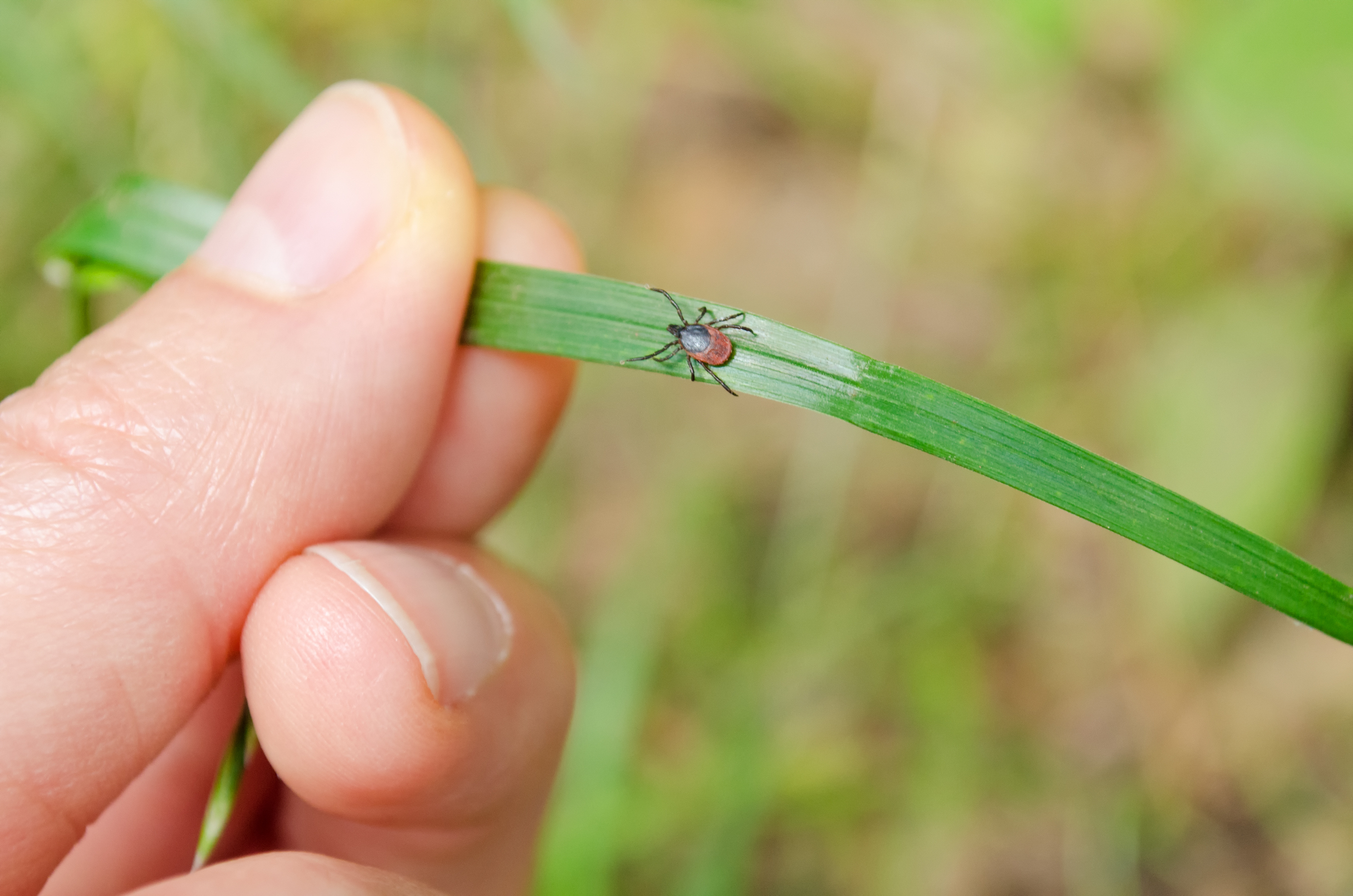10 ways to avoid summer tick bites
Experts shared tips with Live Science on how to protect yourself from tick bites and reduce your risk of tick-borne diseases.

Summertime means outdoor play, hiking, gardening — and tick bites. The creepy-crawlies tend to be most active during the warm months of the year in the U.S., between April and September, and these arachnids are ubiquitous throughout the country.
But tick bites are more than just a spring and summer nuisance. Each year, about 476,000 people in the U.S. get Lyme disease, which is caused by bacteria transferred to humans from tick bites, the Centers for Disease Control and Prevention (CDC) estimates. Thousands more people develop other tick-borne diseases each year, such as the malaria-like disease babesiosis, the flu-like anaplasmosis and the rare but potentially deadly Powassan virus infection.
But people can take steps to avoid tick bites, beyond the old-standby advice to cover up and avoid tall grass, experts say. From scattering wood chips to sending clothes on a quick ride in the dryer, here are 10 ways to avoid tick bites.
Related: Tick-borne diseases are on the rise. Is climate change to blame?
1. Use bug spray
Insecticides can be used to repel ticks, Thomas Mather, a public health entomologist at the University of Rhode Island and the director of tickencounter.org, told Live Science.
Permethrin, the insecticide found in anti-malarial bed nets, kills adult ticks as well as those in their larval stage, called nymphs, which are the likeliest to harbor Lyme disease. Ideally, people should also buy permethrin-treated clothing, socks and shoes, Mather said.
By contrast, the common bug spray chemical N,N-diethyl-meta-toluamide (DEET) doesn't kill ticks, but it does repel the arachnids and thus makes tick bites less likely.
Get the world’s most fascinating discoveries delivered straight to your inbox.
"It's not toxic to the ticks," Mather told Live Science. "They still can scurry across a DEET-treated surface, and get to places where the DEET is not," such as a warm human leg, he said. The Environmental Protection Agency (EPA) offers a handy search tool to help consumers find the best EPA-registered insect repellent to suit their needs.
2. Be vigilant at home
Hiking and camping aren't the most common ways to catch a tick-borne disease, said Kirby Stafford III, a scientist emeritus at The Connecticut Agricultural Experiment Station and author of the "Tick Management Handbook" (The Connecticut Agricultural Experiment Station, 2007).
"We estimate three-fourths of people pick up the ticks in activities in and around the home," with children's play and gardening being some of the riskiest activities, Stafford told Live Science.
Parents should also make sure to do tick checks on children when they come inside, he said.

3. Stay in the sun
Tick nymphs have leaky cuticles, or outer covers, that rapidly lose moisture. As a result, they can't survive in environments with lower than 80% humidity for more than eight hours, Mather said.
As a result, nymphs congregate in leaf piles in shady, humid environments, so sticking to sunny areas can reduce tick exposure, he said.
4. Change the landscape
Most ticks around homes stay within a few yards of the interface between the yard and a wooded area, Stafford said.
To keep your yard tick-free, use landscaping that deters mice, deer, woodchucks and other animals that carry ticks, he said. People should also remove common tick habitats — such as leaf piles, shrubs and ground cover — near the house. Play sets should be kept in the sun, away from the shade, he added.
Ticks won't cross a barrier of wood chips placed around the yard's perimeter, perhaps because the material makes them dry out too much, he said.
5. Check the dog
Various species of tick — including the American dog tick (Dermacentor variabilis) and lone star tick (Amblyomma americanum) — bite dogs and can also transmit diseases to humans, so pet owners should check for the bugs on pets as soon as they come indoors.
"Give them a good rubdown and give them a good spray with the hose. They hate it but you can make it fun," said Holly Donohoe, an adjunct professor at Flagler College in St. Augustine, Florida. The CDC offers additional guidance on how to check dogs for ticks and prevent Fido from getting ticks in the first place.
Related: Dog ticks prefer humans as hosts when temperatures rise

6. Cover up
Covering up as much skin as possible while you're outside can prevent ticks from latching on, Donohoe said.
"Tucking pants into socks is a totally nerdy-looking thing, but in this case, it can save you the suffering from a tick-borne disease later on," Donohoe said.
Of course, that advice may be hard to follow during peak tick season, Stafford said. "In the summer months, nobody is going to do that; it's too hot. I don't," he said. "I'll be protected from ticks but keel over from heatstroke," he said. Thus, other prevention measures may be more useful when the mercury rises.
7. Wear light-colored clothing
In addition to providing coverage, the clothes people wear should be light in color, said Kathryn Berger, a machine learning engineer at Development Seed and a former disease ecologist at the University of Calgary in Canada.
"Nymphal ticks are about the size of a poppy seed, so if you wear lighter-colored clothing like light socks, lighter-colored pants, you're going to have an easier time identifying them."
8. Put your clothes through the dryer
Because ticks are so vulnerable to drying out, the hitchhiking parasites can be killed by giving clothing a quick whirl in the dryer on high heat for five minutes, Mather said.
Ticks can survive the wash cycle, and people who have to both wash and dry their clothes may just toss their clothing into a pile to clean later. However, it's better to do a quick dry cycle immediately when you bring the clothes inside than to let the tick linger on your dirty clothes, he said.
9. Shower and inspect
After spending time outdoors — particularly in grassy, brushy or wooded areas — people should immediately take off their clothes and do a tick inspection of their skin and then shower. People who are in the habit of showering immediately after outdoor activities are less likely to get Lyme disease, perhaps because they can catch any biting ticks before they've transmitted the disease, Stafford said.
After biting, ticks can take several hours to transmit Lyme disease, said Laura Kramer, director of the Arbovirus Laboratory at the New York State Department of Health's Wadsworth Center. Usually, a tick must be attached for 36 to 48 hours or longer for the Lyme-causing bacterium to be transmitted, the CDC states. Removing a tick quickly (within 24 hours) can dramatically reduce your chances of contracting Lyme disease.
10. Remove the tick
If, after taking all these precautions, people do get bitten by a tick, they should remove the arachnid immediately with tweezers or forceps, experts said. The CDC recommends pulling the tick straight up with even, steady pressure, rather than twisting the pest, and then cleaning the bite wound with rubbing alcohol or soap and water.
It's important to visit a doctor if flu-like symptoms or a suspicious rash appear, and to bring the tick in for testing by a state health department to see if it harbors any diseases, Kramer told Live Science. The rash associated with Lyme disease typically looks like a reddish bull's-eye, although it doesn't appear in an estimated 20% to 30% of people with the infection.
Editor's note: This article was originally published on June 6, 2014, and was last updated on June 14, 2023.
This article is for informational purposes only and is not meant to offer medical advice.

Tia is the editor-in-chief (premium) and was formerly managing editor and senior writer for Live Science. Her work has appeared in Scientific American, Wired.com, Science News and other outlets. She holds a master's degree in bioengineering from the University of Washington, a graduate certificate in science writing from UC Santa Cruz and a bachelor's degree in mechanical engineering from the University of Texas at Austin. Tia was part of a team at the Milwaukee Journal Sentinel that published the Empty Cradles series on preterm births, which won multiple awards, including the 2012 Casey Medal for Meritorious Journalism.
- Anna GoraHealth Writer
- Nicoletta LaneseChannel Editor, Health


